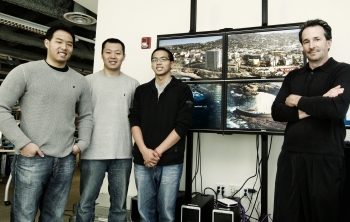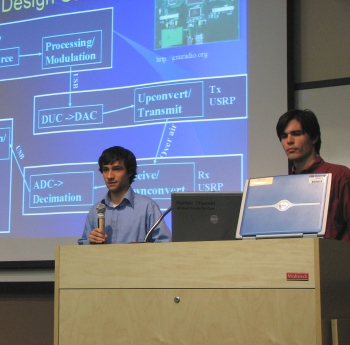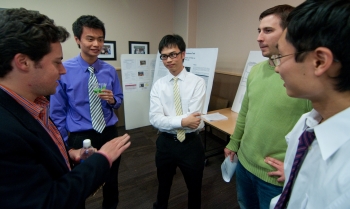Engineering Students Give Final Presentations of Group Design Projects
By Maureen C. Curran
|
San Diego, CA, April 17, 2009 — Engineering undergraduates in last quarter's Electrical and Computer Engineering (ECE) department's group design project course gave their final presentations to a packed house of students, mentors, faculty and friends last month in the Henry G. Booker conference suite in EBU-1.
ECE 191 provides students with hands-on experience working in a team to design, build, demonstrate and document an open-ended engineering project. It is part of the design requirement for the ECE major and is typically taken by seniors. The projects are funded and mentored by Calit2 and other campus organizations and by corporate affiliates of the Jacobs School of Engineering.
"All the presentations were excellent, very confident and enthusiastic," said first-time coinstructor Mohan Trivedi, an ECE professor. "The students obviously knew what they had learned and were eager to share that with others. I feel very good and very happy that I had the chance to interact with them." Trivedi is not new to working closely with undergraduates, there are always some in his lab working as interns or doing independent studies and special projects. In addition, he taught another project-oriented class last fall, and about a third of those students enrolled in this class. Trivedi joined Pankaj Das, the perennial instructor for ECE 191 and an adjunct professor in ECE.
|
Project mentors also enjoy working closely with the student teams. "ECE 191 is an extraordinary course in the electrical and computer engineering undergraduate curriculum," noted Calit2 research scientist B. S. Manoj, "and we are happy to mentor students." Manoj also lectures on networking in the ECE department.
"The OptIPortal Team was very excited to have the opportunity to work with the undergraduate community," first-time mentor Joe Keefe recounted. "This experience should allow us to better document our public access information concerning the building of OptIPortals." Keefe is a research project manager at Calit2.
Calit2 sponsored or cosponsored half of the students (19 of 38 total), working on six of the 13 projects in the winter quarter. Calit2's six projects covered a wide variety of subjects: a touch screen application for Gizmo; prototyping of cognitive network devices; a physical activity meter; a multipurpose, high-resolution display system; software-defined radio; and computer-aided learning games.
Stephen Laplante, Candice Mudrick and Philip Huang worked with mentors B. S. Manoj and Bheemarjuna Reddy Tamma of Calit2 on "Development of Autonomous Cognitive Access Point for Wi-Fi Hotspots," which was part of the Calit2 CogNet project. CogNet project researchers have developed a set of essential modules for realizing the concept of a cognitive enterprise wireless networking system. Their plan was also to build a prototype device integrating the various modules and to develop a testbed for the cognitive wireless networking system.
|
The mentors were very happy with the students and the project. "We had a very talented and dedicated group of students and we are very pleased with their work," said Calit2 postdoc Tamma.
"What we observed at the end of the project was something extraordinary," raved Manoj. "An actual prototype for an autonomous cognitive network access point! In addition, they went on to develop a real-time demonstration of their system as well as a web-based interface for observing the performance."
"Such a cognitive network system has the ability to perceive current wireless network conditions, and then autonomously plan, decide and act on those conditions for improving system performance and user satisfaction," explained Tamma, "It relieves the burden of manual monitoring of the network state and determining an optimum network configuration from the network administrators."
"It was hard at first and we needed a lot of help," said Candice Mudrick of the CogNet project. "But by the last couple of weeks, we were working well without too much assistance." Added Philip Huang: "It was a great experience. Dr. Manoj and Dr. Tamma were great mentors."
|
Calit2's Srinivas Sukumar and Joe Keefe mentored students Joe Tsung-Ying Yeh, Randall Di-Wei Yuan, Lan Bai and Billy Dzuy Nguyen on the "Multi-Purpose Community Content and Display System" project. The project involves building a nine-tile (3x3) high-resolution display system for the Town & Country Village Learning Center, a community organization in an affordable-housing complex in southeast San Diego, which has several ongoing projects with UC San Diego.
"The kids there are less fortunate," said Randy Yuan. "This system will allow them to see images of places they have never seen before, such as Yosemite, Scion, even the beach -- which many have never seen -- in the highest resolution possible. It will be as if they were looking out a window at these images."
"We will be able to bring the world to them," added teammate Lan Bai. Students at the center will also be able to create their own content for the display. It is noteworthy that the monitors in the system cost just $200 each, whereas a single screen of the same overall size would be thousands of dollars.
|
The morning of their final presentations, the team demonstrated a 2x2-tile version of the display system for the learning center's director, Veverly Anderson, who was very pleased with the progress being made on the project. This was part of an ongoing project of the Jacobs School's Teams in Engineering Service (TIES) program. The TIES project continues into the spring quarter, when another group of undergraduates will be building the framework for the full-sized tiled display structure. All four of the team are committed to continuing the project to the completion of the 3x3 version, some weeks into the spring quarter.
"The team was very easy to work with," said Calit2's Keefe. "Their systems skills were very extensive, which allowed us to test the latest versions of the middleware and cluster management with little interruption."
Calit2's Gizmo mobile communications and sensor platform gained new functionality from Jason Gar-Wai Mak, Scott Thomas Kayser and Anna H Nguyen, who worked with Calit2 development engineers Javier Rodriguez Molina, Jeff Cuenco and Don Kimball on a "Gizmo Touch Screen Application." Kimball is a principal development engineer and the head of Calit2's Circuits Laboratory.
"The project with Gizmo was really fun," said Scott Kayser. "I've learned a lot from this entire project."
|
"I enjoyed it a lot, it's nice working as a team," remarked Anna Nguyen. "Learning how to move around problems and obstacles and being able to bounce ideas off one another, applying theory to an application."
Students Joseph P. Sabet, Tommy Truong and Joshua Xavier Ramos worked with Calit2 project scientist Paul Blair on a "Physical Activity Meter." The team created a prototype for a physical activity monitor that can measure activity and store the data. The computer code used is open source and the data is stored in a filesystem which can be easily accessed by any computer operating system. They created an overall design that saves the activity levels and time count to show how long an activity has been performed. The prototype also has the functionality of being able to count steps like a pedometer.
Lawrence Chan Leung, Felix Chou and Luis Manuel Huang worked on "Building Radically Affordable Computer-Aided Learning Games for Developing Regions Using $12 TV-Computers" with mentors Srinivas Sukumar and Paul Blair, as well as Derek Lomas, an MFA candidate in Visual Arts. The students helped produce new frameworks for computer-aided learning games that can be used on the $12 computers which are readily available in India and China.
|
Bill Hodgkiss, associate director of the UCSD division of Calit2, mentored John Thomas Burch, Isaac Martin Caldwell and Matthew A. Costa on a "Software Defined Radio (SDR)" project. Hodgkiss is also a professor at Scripps Institution of Oceanography and an adjunct professor in ECE. The group was co-sponsored by Scripps and Calit2.
An SDR has the radio's signal processing functions in the software, as opposed to the traditional implementation in hardware; this provides a more easily modifiable framework. The team implemented an FM transceiver in software and in hardware, both of which functioned properly. A mic input was able to be captured, modulated, transmitted, received and demodulated on the other end.
In addition to Calit2 and Scripps, project sponsors for winter quarter ECE 191 projects included the Center for Research in Computing and the Arts (CRCA), Raytheon, Spirit AeroSystems & UC San Diego's Center of Excellence for Advanced Materials (CEAM), SPAWAR, NeuroVigil, ViaSat and MagCanica.
The ViaSat-sponsored team of Ryan Anthony Amico and Edward Ang Tran, who were mentored by Chuck Pateros and David Casterton, won the award for best project of the quarter for their work on "Rapid Deployment Satellite Communications Equipment."
|
Kerry Jefferson Daniels, Julio Alfredo Flores and Jason Reginald Hightower worked on "Integrated Network Test and Configuration Tool II (INTACT 2)" with long-time mentor Michael Deshler of Raytheon. They were awarded second place. Third place went to the team of Patrick Pak-Lin Ng, Jeffrey S Jou and Kevin Liu, who worked on an "iBrain Automated Hardware Test" with mentors David Casterton, Jeffrey Thoma and Philip Low, all from first-time sponsor NeuroVigil.
One aspect of ECE 191 is to help students learn how to present their work, including making presentations throughout the quarter, as well as the corresponding slides.
"I think this class really helped in giving me confidence and a sense of how to summarize things without making it too simple or too complicated," said Joe Yeh, who worked on the tiled-display project. "I didn't have the chance to do that before in any of my engineering classes. Wherever I work, I'm going to have to give talks, as well as update colleagues on my work."
"The nice thing is that we can see the difference in the students from week one to week ten," enthused coinstructor Trivedi.









